| Larentia | |
|---|---|
 | |
| Scientific classification | |
| Kingdom: | |
| Phylum: | |
| Class: | |
| Order: | |
| Family: | |
| Subfamily: | |
| Tribe: | |
| Genus: | Larentia Treitschke, 1825 |
| Synonyms | |
| |
Larentia is a genus of moths in the family Geometridae first described by Treitschke in 1825.
| Larentia | |
|---|---|
 | |
| Scientific classification | |
| Kingdom: | |
| Phylum: | |
| Class: | |
| Order: | |
| Family: | |
| Subfamily: | |
| Tribe: | |
| Genus: | Larentia Treitschke, 1825 |
| Synonyms | |
| |
Larentia is a genus of moths in the family Geometridae first described by Treitschke in 1825.

The geometer moths are moths belonging to the family Geometridae of the insect order Lepidoptera, the moths and butterflies. Their scientific name derives from the Ancient Greek geo γῆ or γαῖα "the earth", and metron μέτρον "measure" in reference to the way their larvae, or "inchworms", appear to "measure the earth" as they move along in a looping fashion. A very large family, it has around 23,000 species of moths described, and over 1400 species from six subfamilies indigenous to North America alone. A well-known member is the peppered moth, Biston betularia, which has been subject of numerous studies in population genetics. Several other geometer moths are notorious pests.
Larentia may refer to:

Larentiinae is a subfamily of moths containing roughly 5,800 species that occur mostly in the temperate regions of the world. They are generally considered a subfamily of the geometer moth family (Geometridae) and are divided into a few large or good-sized tribes, and numerous very small or even monotypic ones which might not always be valid. Well-known members are the "pug moths" of the Eupitheciini and the "carpets", mainly of the Cidariini and Xanthorhoini. The subfamily was described by Philogène Auguste Joseph Duponchel in 1845.

Orthonama obstipata, the gem, is a moth of the family Geometridae. The species was first described by Johan Christian Fabricius in 1794. It is common in continental Europe and adjacent lands, though in the northeast, its range does not significantly extend beyond the Baltic region and it is absent from northern Russia. This well-flying species is somewhat prone to vagrancy and able to cross considerable distances of open sea; it can thus be regularly found on the British Isles and even on Iceland.
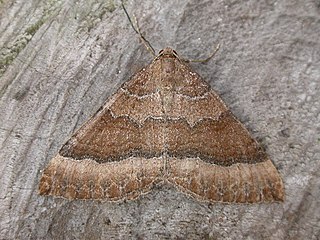
Larentia clavaria, the mallow, is a moth of the family Geometridae. The species was first described by Adrian Hardy Haworth in 1809. It is found from Siberia in the east to the Iberian Peninsula, North Africa, and the British Isles in the west. In the north it ranges to the Caucasus, Tajikistan and Fennoscandia. In the south it is found the western Mediterranean islands, Italy, the Balkans and Asia Minor. It occurs only locally and is almost always rare. In the Alps, it rises up to 1200 m above sea level.

Epyaxa lucidata is a species of moth in the family Geometridae. It is endemic to New Zealand.

Helastia is a genus of moths in the family Geometridae erected by Achille Guenée. It is considered by some to be a synonym of Larentia.

Larentiini is a tribe of geometer moths under subfamily Larentiinae. The tribe was first described by Philogène Auguste Joseph Duponchel in 1845.
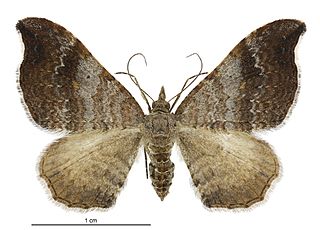
Homodotis megaspilata is a moth of the family Geometridae. It is endemic to New Zealand.

Larentia malvata is a moth of the family Geometridae. It was described by Rambur in 1833. It is found in Portugal, Spain, France, Italy, Croatia, Greece, as well as on Sardinia, Corsica, Sicily, Malta and Crete.

Aponotoreas anthracias is a moth of the family Geometridae. It is endemic to New Zealand. This species was first described by Edward Meyrick in 1883 under the name Larentia anthracias. Specimens of this species have been collected in the Maungatua ranges, the Remarkables and the Hawkdun Ecological District in Otago. The host plant of this moth is Dracophyllum.
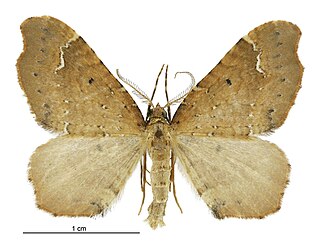
Asaphodes camelias is a species of moth in the family Geometridae. It is endemic to New Zealand. Specimens of this species have been collected in the southern North Island hill country, as well as near the Waitaha River and at Paroa, both in the South Island. A. camelias is regarded a typical species of the West Coast region and have been trapped during the months of February to May as well as July to September.

Asaphodes cataphracta is a moth in the family Geometridae. It is endemic to New Zealand and is found in the South Island.

Asaphodes chionogramma is a moth in the family Geometridae. It is endemic to New Zealand.
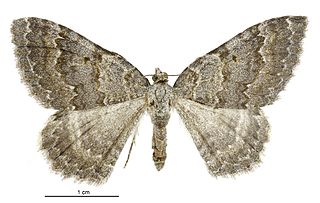
Gingidiobora subobscurata is a species of moth in the family Crambidae. It is endemic to New Zealand. This species has been classified as "At Risk, Declining" by the Department of Conservation.

Asaphodes cinnabari is a species of moth in the family Geometridae. This species is endemic to New Zealand and can be found in Otago and Southland where it lives in alpine swampy habitat.

Asaphodes clarata is a species of moth in the family Geometridae. This species is endemic to New Zealand.
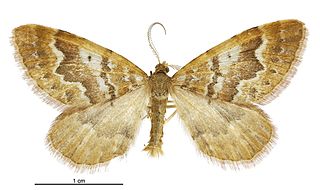
Asaphodes exoriens is a species of moth in the family Geometridae. This species is endemic to New Zealand.

Orthoclydon chlorias is a species of moth in the family Geometridae. It is endemic to New Zealand.
| This Larentiini moth related article is a stub. You can help Wikipedia by expanding it. |